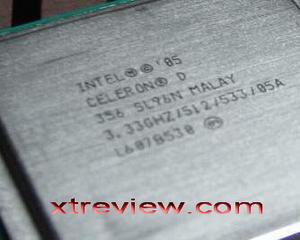OOPS! You forgot to upload swfobject.js ! You must upload this file for your form to work.
celeron CedarMill overclocking
![]()
|
xtreview is your : Video card - cpu - memory - Hard drive - power supply unit source |
|
|||
|
|
||||
 Recommended : Free unlimited image hosting with image editor
Recommended : Free unlimited image hosting with image editor
|
POSTER: hardware news || CELERON CEDARMILL OVERCLOCKING |
DATE:2006-06-20 |
|
|
we have been recently too busy searching for conroe info date launch etc and we have forget that recently there were 0.065 microns version of processors Celeron D which are based on C1 stepand core CedarMill. .this steppeningis hard to findamong retail processors Pentium D 9xx,. Moreover, in the end of July these processors become cheaper, and can pass on stepeningD0 in the autumn. By the way, many mainboard manufacturers in the lists compatibilityof 0.065 microns Celeron D processors Hint for the exictance ofstep B1. Certainly, it not accident but is overclockingsuch processors can hardly be worse. From economic point it is more favourable formanufacture to usebudget processors withold core stepening. Celeron D on the basis of 0.065 microns coreCedarMill was overclockedup to 5.0 GHz with use of powerful air coolers . thegood overclockingpotential promoted not only decent frequency potential of 0.065 microns cpubut also a high nominal multiplier of these processors. today on pages of forum XtremeSystems.org there was a description of experiment on overclockingthe Celeron D 356 (3.33 GHz) processor stepC1 up to 5.4 GHz withusing an air cooler. More precisely speaking, it was possible to take a screenshot of 5.4ghz GHz only, but the voltage on the core was low enough - 1.4v. note that runing at 5.1ghz at this low voltage cpu has passed stability test A gain of frequency 50-60 % without special efforts - not all today processors are capable for such high overclocking potential. we appreciate the advantages of the high nominal multipler(25x) - for overclockingup to 5.4 GHz .the system bus was at only 218 mhz. Formally processors Celeron D support 533 MHz busthat corresponds 133 MHz fsb . Versions Celeron D 3xx on 0.065 microns have twice greater cache of the second level in comparison with predecessors: 512 KB vs256 KB. this will also affect the system performance, plus the great overclocking potential. | ||
|
|
||
|
xtreview is your : Video card - cpu - memory - Hard drive - power supply unit source |
|
|
|
|
||
|
Xtreview Support  N-Post:xxxx Xtreview Support        |
CELERON CEDARMILL OVERCLOCKING |
| Please Feel Free to write any Comment; Thanks  |
Intel CedarMill at 8308.9 MHz and a new world record (2011-08-22)
Intel CedarMill processor to be removed (2007-04-04)
CedarMill-D0 to wait more (2006-12-14)
celeron D cedarMill-D0 overclocking (2006-12-08)
celeron CedarMill overclocking (2006-06-20)
![]()
To figure out your best laptops .Welcome to XTreview.com. Here u can find a complete computer hardware guide and laptop rating .More than 500 reviews of modern PC to understand the basic architecture


7600gt review
7600gt is the middle card range.
We already benchmarked this video card and found that ...

 geforce 8800gtx and 8800gts
geforce 8800gtx and 8800gts  Xtreview software download Section
Xtreview software download Section  AMD TURION 64 X2 REVIEW
AMD TURION 64 X2 REVIEW  INTEL PENTIUM D 920 , INTEL PENTIUM D 930
INTEL PENTIUM D 920 , INTEL PENTIUM D 930  6800XT REVIEW
6800XT REVIEW  computer hardware REVIEW
computer hardware REVIEW  INTEL CONROE CORE DUO 2 REVIEW VS AMD AM2
INTEL CONROE CORE DUO 2 REVIEW VS AMD AM2  INTEL PENTIUM D 805 INTEL D805
INTEL PENTIUM D 805 INTEL D805  Free desktop wallpaper
Free desktop wallpaper  online fighting game
online fighting game  Xtreview price comparison center
Xtreview price comparison center Lastest 15 Reviews


Rss Feeds
Last News
- The new version of GPU-Z finally kills the belief in the miracle of Vega transformation
- The motherboard manufacturer confirms the characteristics of the processors Coffee Lake
- We are looking for copper coolers on NVIDIA Volta computing accelerators
- Unofficially about Intels plans to release 300-series chipset
- The Japanese representation of AMD offered monetary compensation to the first buyers of Ryzen Threadripper
- This year will not be released more than 45 million motherboards
- TSMC denies the presentation of charges from the antimonopoly authorities
- Radeon RX Vega 64 at frequencies 1802-1000 MHz updated the record GPUPI 1B
- AMD itself would like to believe that mobile processors Ryzen have already been released
- AMD Vega 20 will find application in accelerating computations
- Pre-orders for new iPhone start next week
- Radeon RX Vega 57, 58 and 59: the wonders of transformation
- ASML starts commercial delivery of EUV-scanners
- The older Skylake processors with a free multiplier are removed from production
- Meizu will release Android-smartphone based on Helio P40
- AMD Bristol Ridge processors are also available in American retail
- The fate of Toshiba Memory can be solved to the next environment
- duo GeForce GTX 1080 Ti in GPUPI 1B at frequencies of 2480-10320 MHz
- New Kentsfield overclocking record up to 5204 MHz
- Lenovo released Android-smartphone K8

HALO 3 HALO 3 - Final Fight!

PREY Prey is something you don t often see anymore: a totally unigue shooter experience.

computer news computer parts review Old Forum Downloads New Forum Login Join Articles terms Hardware blog Sitemap Get Freebies




